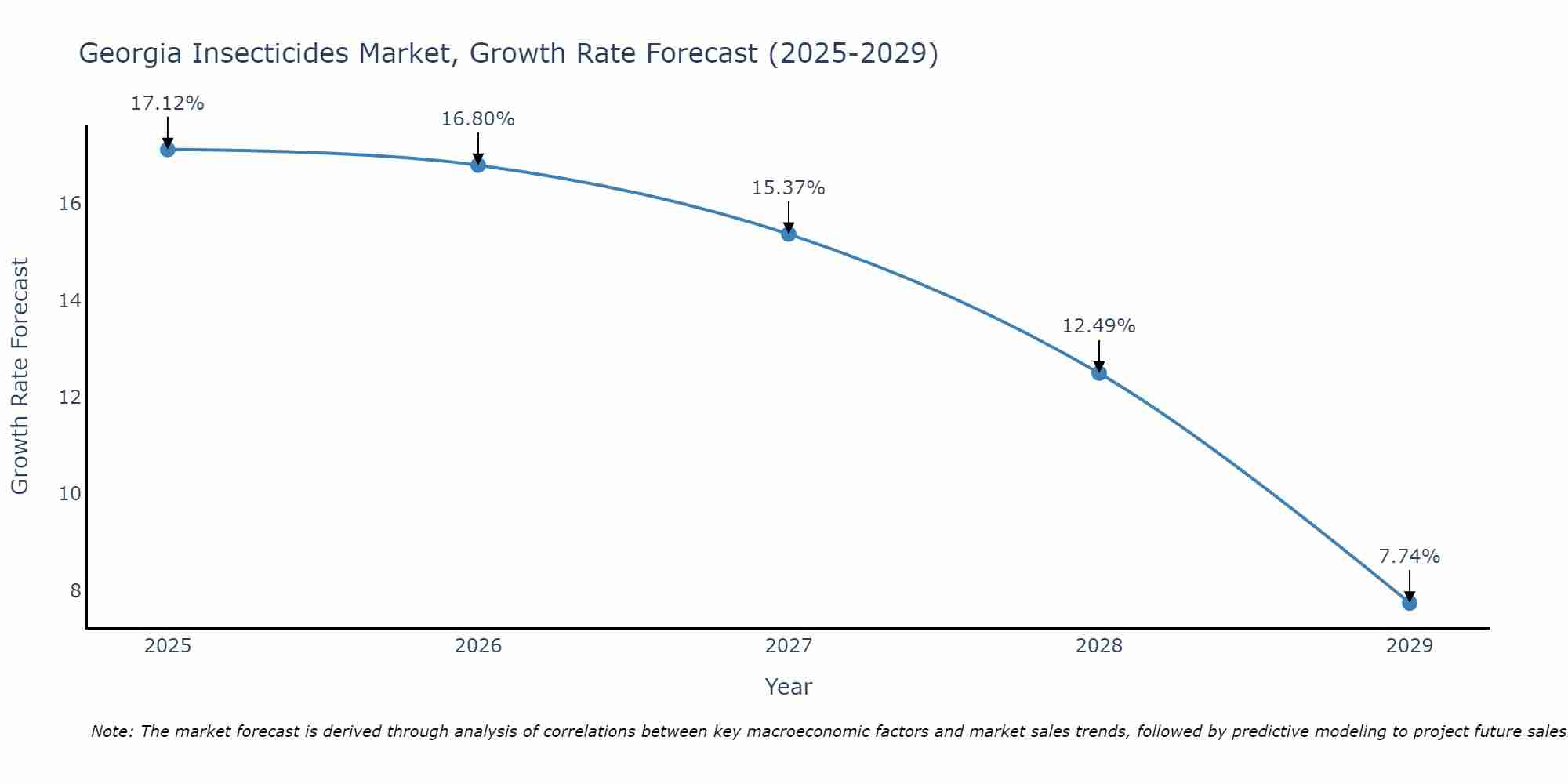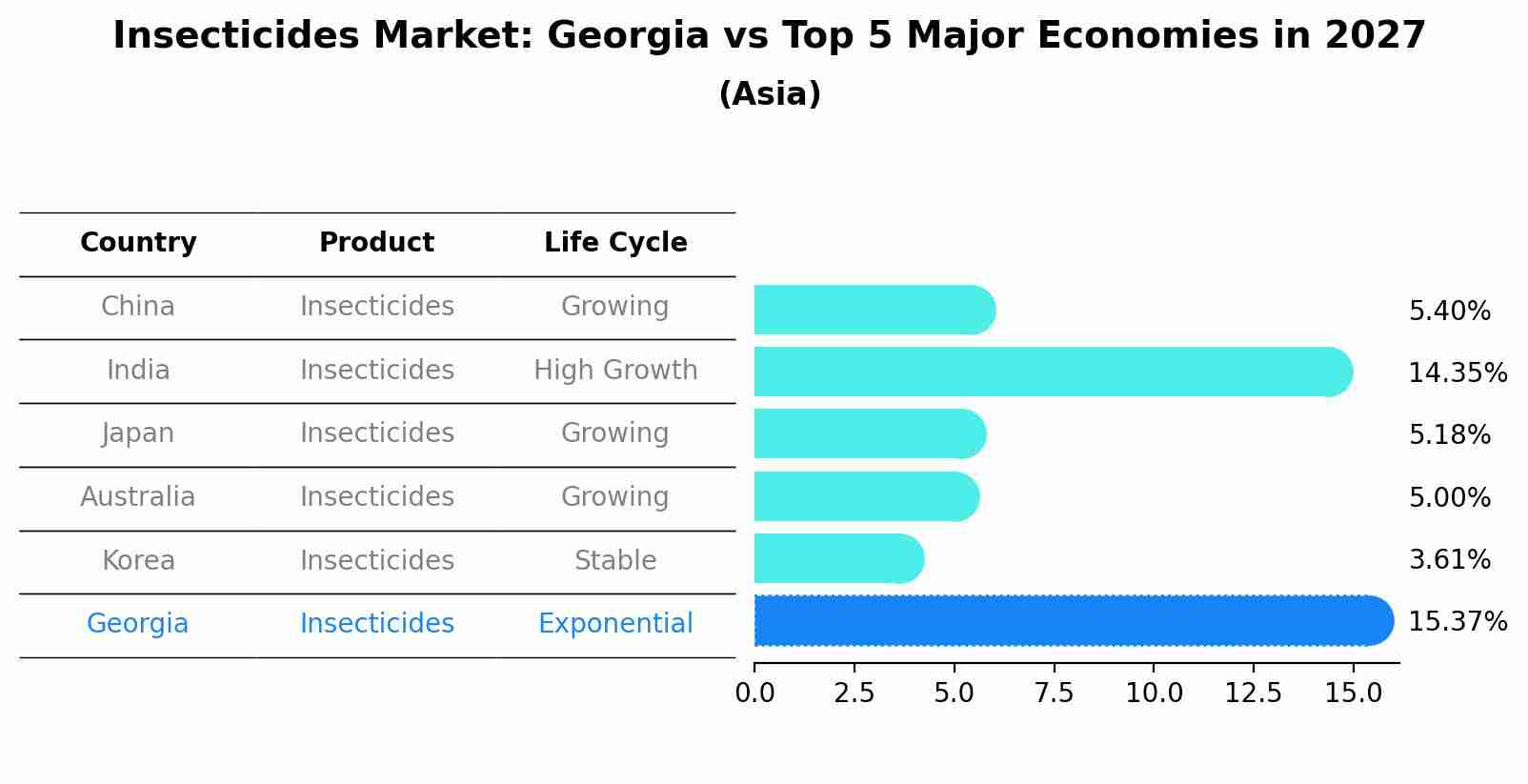Georgia Insecticides Market (2020-2026) | Revenue, Growth, Trends, Analysis, Size, Forecast, Share, COVID-19 IMPACT, Companies, Value, Industry & Outlook
| Product Code: ETC025880 | Publication Date: Oct 2020 | Updated Date: Apr 2025 | Product Type: Report | |
| Publisher: 6Wresearch | Author: Ravi Bhandari | No. of Pages: 70 | No. of Figures: 35 | No. of Tables: 5 |
Georgia Insecticides Market Size Growth Rate
The Georgia Insecticides Market could see a tapering of growth rates over 2025 to 2029. Beginning strongly at 17.12% in 2025, growth softens to 7.74% in 2029.

Insecticides Market: Georgia vs Top 5 Major Economies in 2027 (Asia)
Georgia's Insecticides market is anticipated to experience a exponential growth rate of 15.37% by 2027, reflecting trends observed in the largest economy China, followed by India, Japan, Australia and South Korea.

Georgia Insecticides Market Overview
The insecticides market in Georgia is witnessing steady growth fueled by the agricultural sector`s need for effective pest control solutions. Insecticides play a crucial role in protecting crops from various pests and diseases, thereby ensuring higher yields and better quality produce. Factors such as increasing pest resistance, expanding agricultural land, and rising demand for high-value crops are driving the growth of the insecticides market in Georgia. Additionally, technological advancements in insecticide formulations and application methods are further contributing to market expansion.
Drivers of the market
The Georgia insecticides market is driven by several factors including the growing agricultural sector, rising pest infestations, and the need for effective pest management solutions. With a significant portion of Georgia economy reliant on agriculture, farmers are increasingly turning to insecticides to protect crops from pests and diseases, thereby driving market growth. Additionally, the introduction of novel insecticide formulations and advancements in pest control technologies are contributing to market expansion.
Challenges of the market
In the Georgia insecticides market, one of the major challenges is the need for effective pest management strategies while minimizing harm to beneficial insects and the environment. Balancing the necessity of pest control with ecological sustainability is a complex task for both producers and regulators. Additionally, there is growing consumer awareness and demand for organic and natural pest control methods, which presents a challenge for traditional chemical insecticide manufacturers to adapt their product offerings and marketing strategies accordingly.
Government Policy of the market
In response to concerns about the impact of insecticides on pollinators and non-target organisms, the government of Georgia has introduced regulations to monitor and restrict the use of certain insecticide compounds. These regulations include bans on highly toxic insecticides, restrictions on application methods to minimize drift, and requirements for integrated pest management practices. Furthermore, there are initiatives to educate farmers and stakeholders about the safe use of insecticides and promote the adoption of biological control methods.
Key Highlights of the Report:
- Georgia Insecticides Market Outlook
- Market Size of Georgia Insecticides Market, 2019
- Forecast of Georgia Insecticides Market, 2026
- Historical Data and Forecast of Georgia Insecticides Revenues & Volume for the Period 2016 - 2026
- Georgia Insecticides Market Trend Evolution
- Georgia Insecticides Market Drivers and Challenges
- Georgia Insecticides Price Trends
- Georgia Insecticides Porter's Five Forces
- Georgia Insecticides Industry Life Cycle
- Historical Data and Forecast of Georgia Insecticides Market Revenues & Volume By Crop Type for the Period 2016 - 2026
- Historical Data and Forecast of Georgia Insecticides Market Revenues & Volume By Cereals & grains for the Period 2016 - 2026
- Historical Data and Forecast of Georgia Insecticides Market Revenues & Volume By Oilseeds & pulses for the Period 2016 - 2026
- Historical Data and Forecast of Georgia Insecticides Market Revenues & Volume By Fruits & vegetables for the Period 2016 - 2026
- Historical Data and Forecast of Georgia Insecticides Market Revenues & Volume By Other crop types for the Period 2016 - 2026
- Historical Data and Forecast of Georgia Insecticides Market Revenues & Volume By Formulation for the Period 2016 - 2026
- Historical Data and Forecast of Georgia Insecticides Market Revenues & Volume By Wettable powder for the Period 2016 - 2026
- Historical Data and Forecast of Georgia Insecticides Market Revenues & Volume By Emulsifiable concentrate for the Period 2016 - 2026
- Historical Data and Forecast of Georgia Insecticides Market Revenues & Volume By Suspension concentrate for the Period 2016 - 2026
- Historical Data and Forecast of Georgia Insecticides Market Revenues & Volume By Oil emulsion in water for the Period 2016 - 2026
- Historical Data and Forecast of Georgia Insecticides Market Revenues & Volume By Microencapsulated suspension for the Period 2016 - 2026
- Historical Data and Forecast of Georgia Insecticides Market Revenues & Volume By Granules for the Period 2016 - 2026
- Historical Data and Forecast of Georgia Insecticides Market Revenues & Volume By Other formulations for the Period 2016 - 2026
- Historical Data and Forecast of Georgia Insecticides Market Revenues & Volume By Forms for the Period 2016 - 2026
- Historical Data and Forecast of Georgia Insecticides Market Revenues & Volume By Sprays for the Period 2016 - 2026
- Historical Data and Forecast of Georgia Insecticides Market Revenues & Volume By Baits for the Period 2016 - 2026
- Historical Data and Forecast of Georgia Insecticides Market Revenues & Volume By Strips for the Period 2016 - 2026
- Georgia Insecticides Import Export Trade Statistics
- Market Opportunity Assessment By Crop Type
- Market Opportunity Assessment By Formulation
- Market Opportunity Assessment By Forms
- Georgia Insecticides Top Companies Market Share
- Georgia Insecticides Competitive Benchmarking By Technical and Operational Parameters
- Georgia Insecticides Company Profiles
- Georgia Insecticides Key Strategic Recommendations
Frequently Asked Questions About the Market Study (FAQs):
1 Executive Summary |
2 Introduction |
2.1 Key Highlights of the Report |
2.2 Report Description |
2.3 Market Scope & Segmentation |
2.4 Research Methodology |
2.5 Assumptions |
3 Georgia Insecticides Market Overview |
3.1 Georgia Country Macro Economic Indicators |
3.2 Georgia Insecticides Market Revenues & Volume, 2019 & 2026F |
3.3 Georgia Insecticides Market - Industry Life Cycle |
3.4 Georgia Insecticides Market - Porter's Five Forces |
3.5 Georgia Insecticides Market Revenues & Volume Share, By Crop Type, 2019 & 2026F |
3.6 Georgia Insecticides Market Revenues & Volume Share, By Formulation, 2019 & 2026F |
3.7 Georgia Insecticides Market Revenues & Volume Share, By Forms, 2019 & 2026F |
4 Georgia Insecticides Market Dynamics |
4.1 Impact Analysis |
4.2 Market Drivers |
4.3 Market Restraints |
5 Georgia Insecticides Market Trends |
6 Georgia Insecticides Market, By Types |
6.1 Georgia Insecticides Market, By Crop Type |
6.1.1 Overview and Analysis |
6.1.2 Georgia Insecticides Market Revenues & Volume, By Crop Type, 2016 - 2026F |
6.1.3 Georgia Insecticides Market Revenues & Volume, By Cereals & grains, 2016 - 2026F |
6.1.4 Georgia Insecticides Market Revenues & Volume, By Oilseeds & pulses, 2016 - 2026F |
6.1.5 Georgia Insecticides Market Revenues & Volume, By Fruits & vegetables, 2016 - 2026F |
6.1.6 Georgia Insecticides Market Revenues & Volume, By Other crop types, 2016 - 2026F |
6.2 Georgia Insecticides Market, By Formulation |
6.2.1 Overview and Analysis |
6.2.2 Georgia Insecticides Market Revenues & Volume, By Wettable powder, 2016 - 2026F |
6.2.3 Georgia Insecticides Market Revenues & Volume, By Emulsifiable concentrate, 2016 - 2026F |
6.2.4 Georgia Insecticides Market Revenues & Volume, By Suspension concentrate, 2016 - 2026F |
6.2.5 Georgia Insecticides Market Revenues & Volume, By Oil emulsion in water, 2016 - 2026F |
6.2.6 Georgia Insecticides Market Revenues & Volume, By Microencapsulated suspension, 2016 - 2026F |
6.2.7 Georgia Insecticides Market Revenues & Volume, By Granules, 2016 - 2026F |
6.3 Georgia Insecticides Market, By Forms |
6.3.1 Overview and Analysis |
6.3.2 Georgia Insecticides Market Revenues & Volume, By Sprays, 2016 - 2026F |
6.3.3 Georgia Insecticides Market Revenues & Volume, By Baits, 2016 - 2026F |
6.3.4 Georgia Insecticides Market Revenues & Volume, By Strips, 2016 - 2026F |
7 Georgia Insecticides Market Import-Export Trade Statistics |
7.1 Georgia Insecticides Market Export to Major Countries |
7.2 Georgia Insecticides Market Imports from Major Countries |
8 Georgia Insecticides Market Key Performance Indicators |
9 Georgia Insecticides Market - Opportunity Assessment |
9.1 Georgia Insecticides Market Opportunity Assessment, By Crop Type, 2019 & 2026F |
9.2 Georgia Insecticides Market Opportunity Assessment, By Formulation, 2019 & 2026F |
9.3 Georgia Insecticides Market Opportunity Assessment, By Forms, 2019 & 2026F |
10 Georgia Insecticides Market - Competitive Landscape |
10.1 Georgia Insecticides Market Revenue Share, By Companies, 2019 |
10.2 Georgia Insecticides Market Competitive Benchmarking, By Operating and Technical Parameters |
11 Company Profiles |
12 Recommendations |
13 Disclaimer |
- Single User License$ 1,995
- Department License$ 2,400
- Site License$ 3,120
- Global License$ 3,795
Search
Thought Leadership and Analyst Meet
Our Clients
Related Reports
- Canada Oil and Gas Market (2026-2032) | Share, Segmentation, Value, Industry, Trends, Forecast, Analysis, Size & Revenue, Growth, Competitive Landscape, Outlook, Companies
- Germany Breakfast Food Market (2026-2032) | Industry, Share, Growth, Size, Companies, Value, Analysis, Revenue, Trends, Forecast & Outlook
- Australia Briquette Market (2025-2031) | Growth, Size, Revenue, Forecast, Analysis, Trends, Value, Share, Industry & Companies
- Vietnam System Integrator Market (2025-2031) | Size, Companies, Analysis, Industry, Value, Forecast, Growth, Trends, Revenue & Share
- ASEAN and Thailand Brain Health Supplements Market (2025-2031) | Strategy, Consumer Insights, Analysis, Investment Trends, Opportunities, Growth, Size, Share, Industry, Revenue, Segments, Value, Segmentation, Supply, Forecast, Restraints, Outlook, Competition, Drivers, Trends, Demand, Pricing Analysis, Competitive, Strategic Insights, Companies, Challenges
- ASEAN Bearings Market (2025-2031) | Strategy, Consumer Insights, Analysis, Investment Trends, Opportunities, Growth, Size, Share, Industry, Revenue, Segments, Value, Segmentation, Supply, Forecast, Restraints, Outlook, Competition, Drivers, Trends, Demand, Pricing Analysis, Competitive, Strategic Insights, Companies, Challenges
- Europe Flooring Market (2025-2031) | Outlook, Share, Industry, Trends, Forecast, Companies, Revenue, Size, Analysis, Growth & Value
- Saudi Arabia Manlift Market (2025-2031) | Outlook, Size, Growth, Trends, Companies, Industry, Revenue, Value, Share, Forecast & Analysis
- Uganda Excavator, Crane, and Wheel Loaders Market (2025-2031) | Strategy, Consumer Insights, Analysis, Investment Trends, Opportunities, Growth, Size, Share, Industry, Revenue, Segments, Value, Segmentation, Supply, Forecast, Restraints, Outlook, Competition, Drivers, Trends, Demand, Pricing Analysis, Competitive, Strategic Insights, Companies, Challenges
- Rwanda Excavator, Crane, and Wheel Loaders Market (2025-2031) | Strategy, Consumer Insights, Analysis, Investment Trends, Opportunities, Growth, Size, Share, Industry, Revenue, Segments, Value, Segmentation, Supply, Forecast, Restraints, Outlook, Competition, Drivers, Trends, Demand, Pricing Analysis, Competitive, Strategic Insights, Companies, Challenges
Industry Events and Analyst Meet
Whitepaper
- Middle East & Africa Commercial Security Market Click here to view more.
- Middle East & Africa Fire Safety Systems & Equipment Market Click here to view more.
- GCC Drone Market Click here to view more.
- Middle East Lighting Fixture Market Click here to view more.
- GCC Physical & Perimeter Security Market Click here to view more.
6WResearch In News
- Doha a strategic location for EV manufacturing hub: IPA Qatar
- Demand for luxury TVs surging in the GCC, says Samsung
- Empowering Growth: The Thriving Journey of Bangladesh’s Cable Industry
- Demand for luxury TVs surging in the GCC, says Samsung
- Video call with a traditional healer? Once unthinkable, it’s now common in South Africa
- Intelligent Buildings To Smooth GCC’s Path To Net Zero


















